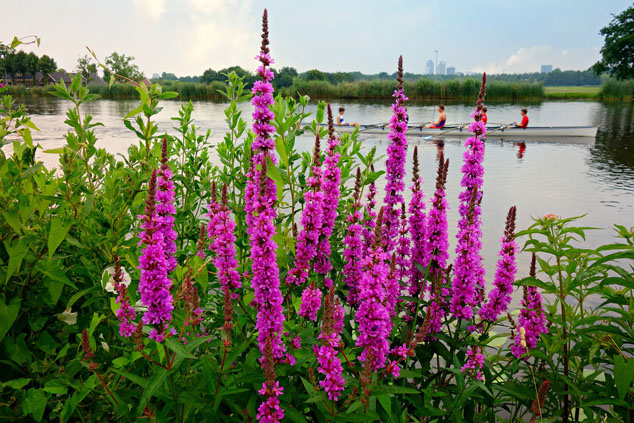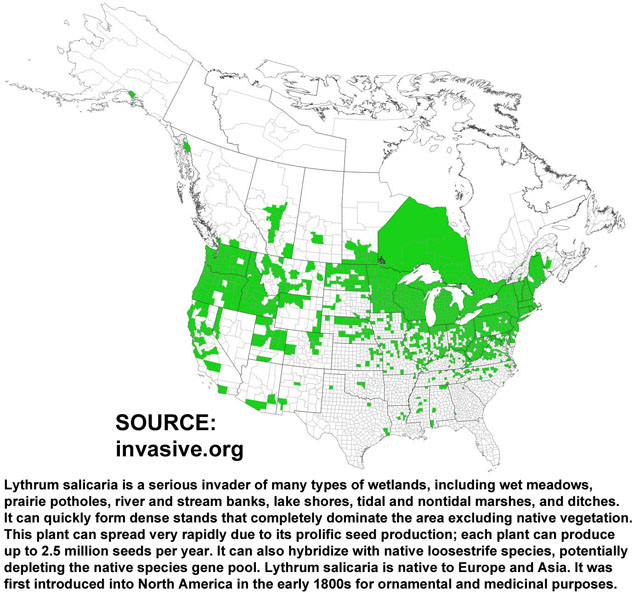 Purple loosestrife health benefits may come as a surprise about this supposedly invasive weed. It has a nice folk medical history backed by modern research.
Purple loosestrife health benefits may come as a surprise about this supposedly invasive weed. It has a nice folk medical history backed by modern research.
Depending on who’s talking about it this species (Lythra salicaria, [Lythraceae]) is either an invasive weed or an herbal medical boon.
Of course, it does tend to take over habitats where it’s been introduced outside of its native areas in Europe, temperate Asia, and northwest Africa. It can dominate in ditches, wet meadows, marshes, and along lakesides. It can outcompete native plants and alter the ecological balance of plants, insects, and birds. Weed control folks have a hard time keeping it under control.
Nevertheless, purple loosestrife sends up beautiful, showy inflorescences that look great in any garden.
What’s most important to me, however, is its medicinal properties. This is where folk medicine and modern scientific research meet.
Summary of Purple Loosestrife Health Benefits
Purple loosestrife has a long folk medical history, which is what you’d expect from a species with such wide natural distribution. Even Dioscorides, the first century Roman physician/botanist, wrote about it in his De Materia Medica, the most widely read medical text for more than 1,500 years.
It’s been used as an astringent for treating dysentery and diarrhea, even for babies.
Its astringent properties also made it useful for stopping bleeding. Also for hemorrhoids, eczema, varicose veins, and bleeding gums.
In recent times research on purple loosestrife has shown its effectiveness as a topical ointment for healing burn wounds.
Behind the scenes, all these activities point to anti-inflammatory activities. More specifically, these activities address stimulation of types of cells called neutrophils. Neutrophils are the most abundant type of white blood cells in humans. This means the anti-inflammatory activity directly boosts powerful cells in the immune system.
Even more recently certain ingredients in this herb showed an ability to inhibit the growth of cancer cells.
And to top off these modern discoveries, research also shows the herb to have anti-diabetic properties, an ability to suppress the ulcer-causing bacterium, Helicobacter pylori, and a remarkable ability to tamp down yeast overgrowth by Candida albicans.
My Favorite Active Ingredients
What I and my fellow plant biochemists like to do is hunt for exactly which ingredients in an herb are responsible for its medicinal properties.
This is where I’m pleased to note my favorite natural products play a significant role. These are the polyphenolics, specifically the ellagitannins and other flavonoids.
Ellagitannins are responsible for the astringency of teas and extracts behind most purple loosestrife health benefits. (The “tannin” part of the name tells us they act like tannins used for tanning leather. Very astringent!)
Studies on anti-cancer effects also discovered triterpenes and sterols to be the active ingredients.
The kicker is all plants synthesize polyphenolics and triterpene sterols. It’s the particular individual ingredients in these classes of natural products driving the purple loosestrife’s medicinal properties.
Where to Get Purple Loosestrife
You’d think such a weedy plant – so weedy it’s considered ‘noxious’ – would be easy to get for health purposes. It certainly can be, depending on where you live.
The most obvious source would be right outside your door. That is, if this beautiful herb has ‘invaded’ your neighborhood. See where it’s been found according to this distribution map.

Growing Your Own
Barring that ‘wild’ source, it’s an easy plant to grow if your climate is cool and wet enough. Seeds may not be available at your local nursery. If that’s the case, you can pick up a packet of 100+ seeds on Amazon here.
HEADS UP: Be very careful not to violate your state’s regulations on growing this species. Many states prohibit cultivating it due to its invasiveness.
Preparations and Dosages
- Leaf & Flower Infusion: 1 tbsp in 1 cup water, steep 10-15 minutes, strain, drink 3 cups/day
- Infused Oil, Infused Honey, Salve, Tincture (40%-50% Alcohol): 1/2-1 tsp 3x/day
- Poultice and Compress: Soak in vinegar (100% raw apple cider vinegar); apply where needed
Where to Buy Purple Loosestrife
If you live in a prohibitive environment like I do in central Arizona, or if you don’t have a green thumb, you can still make your own tea from prepared bags here.

Finally, for those of us on the go, pre-made supplements are also available. E.g., here.

So, have at it!
Previous Articles on Medicinal Herbs
Top 6 Herbs For Edema In Legs And Ankles
Herbs To Heal Leaky Gut
Herbs – Nature’s Antiviral Drugs
Truths About The Benefits Of Chocolate
Comments or Questions?
I’d love to hear from you. This and every other post here provides a comment section at the end of the post, exactly for that purpose.
So, by all means, leave me your thoughts.
I would be especially grateful if you point out any flaws in my logic, factual errors, or ordinary typos. (I’ll give you a little ‘huzzah’ in my heart.)
Then I’ll respond as soon as I can.
References
Becker H, Scher JM, Speakman JB, Zapp J. Bioactivity guided isolation of antimicrobial compounds from Lythrum salicaria. Fitoterapia. 2005 Sep;76(6):580-4. doi: 10.1016/j.fitote.2005.04.011. PMID: 15975734. https://pubmed.ncbi.nlm.nih.gov/15975734/
Bencsik T, Horváth G, Papp N. Variability of total flavonoid, polyphenol and tannin contents in some Lythrum salicaria populations. Nat Prod Commun. 2011 Oct;6(10):1417-20. PMID: 22164772. https://pubmed.ncbi.nlm.nih.gov/22164772/
Bush, B., Shane, L.A., Wilson, L.R. et al. Uptake of polychlorobiphenyl congeners by purple loosestrife (Lythrum salicaria) on the banks of the Hudson river. Arch. Environ. Contam. Toxicol. 15, 285–290 (1986). https://doi.org/10.1007/BF01061105 https://link.springer.com/article/10.1007/BF01061105#citeas
Granica S, Vahjen W, Zentek J, Melzig MF, Pawłowska KA, Piwowarski JP. Lythrum salicaria Ellagitannins Stimulate IPEC-J2 Cells Monolayer Formation and Inhibit Enteropathogenic Escherichia coli Growth and Adhesion. J Nat Prod. 2020 Dec 24;83(12):3614-3622. doi: 10.1021/acs.jnatprod.0c00776. Epub 2020 Dec 3. PMID: 33270444; PMCID: PMC7771025. https://www.ncbi.nlm.nih.gov/pmc/articles/PMC7771025/
Humadi SS, Istudor V. Lythrum salicaria (purple loosestrife). Medicinal use, extraction and identification of its total phenolic compounds. Farmacia. 2009;57(2):192-200. https://www.researchgate.net/publication/228487959_Lythrum_salicaria_Purple_loosestrife_Medicinal_use_extraction_and_identification_of_its_total_phenolic_compounds
Lamela M, Cadavid I, Gato A, Calleja JM. Effects of Lythrum salicaria in normoglycemic rats. J Ethnopharmacol. 1985 Sep;14(1):83-91. doi: 10.1016/0378-8741(85)90032-7. PMID: 3910965. https://pubmed.ncbi.nlm.nih.gov/3910965/
Lamela M, Cadavid I, Calleja JM. Effects of Lythrum salicaria extracts on hyperglycemic rats and mice. J Ethnopharmacol. 1986 Feb;15(2):153-60. doi: 10.1016/0378-8741(86)90152-2. PMID: 3713231. https://pubmed.ncbi.nlm.nih.gov/3713231/
Lavoie C. Should we care about purple loosestrife? The history of an invasive plant in North America. Biol Invasions. 2010;12:1967–1999. DOI 10.1007/s10530-009-960.0-7. https://www.fs.usda.gov/Internet/FSE_DOCUMENTS/stelprdb5373511.pdf
Manayi A, Saeidnia S, Ostad SN, Hadjiakhoondi A, Ardekani MR, Vazirian M, Akhtar Y, Khanavi M. Chemical constituents and cytotoxic effect of the main compounds of Lythrum salicaria L. Z Naturforsch C J Biosci. 2013 Sep-Oct;68(9-10):367-75. PMID: 24459770. https://pubmed.ncbi.nlm.nih.gov/24459770/
Manayi A, Khanavi M, Saeidnia S, Azizi E, Mahmoodpour MR, Vafi F, Malmir M, Siavashi F, Hadjiakhoondi A. Biological activity and microscopic characterization of Lythrum salicaria L. Daru. 2013 Jul 25;21(1):61. doi: 10.1186/2008-2231-21-61. Erratum in: Daru. 2014;22:61. Saiednia, Soodabeh [corrected to Saeidnia, Soodabeh]. PMID: 23885663; PMCID: PMC3751246. https://www.ncbi.nlm.nih.gov/pmc/articles/PMC3751246/
Manayi A, Saeidnia S, Faramarzi MA, Samadi N, Jafari S, Vazirian M, Ghaderi A, Mirnezami T, Hadjiakhoondi A, Ardekani MR, Khanavi M. A comparative study of anti-Candida activity and phenolic contents of the calluses from Lythrum salicaria L. in different treatments. Appl Biochem Biotechnol. 2013 May;170(1):176-84. doi: 10.1007/s12010-013-0185-3. Epub 2013 Mar 14. PMID: 23494219. https://pubmed.ncbi.nlm.nih.gov/23494219/
Pawlaczyk I, Czerchawski L, Kańska J, Bijak J, Capek P, Pliszczak-Król A, Gancarz R. An acidic glycoconjugate from Lythrum salicaria L. with controversial effects on haemostasis. J Ethnopharmacol. 2010 Aug 19;131(1):63-9. doi: 10.1016/j.jep.2010.06.001. Epub 2010 Jun 8. PMID: 20554008. https://www.sciencedirect.com/science/article/abs/pii/S0378874110003867?via%3Dihub
Piwowarski JP, Granica S, Kiss AK. Lythrum salicaria L.-Underestimated medicinal plant from European traditional medicine. A review. J Ethnopharmacol. 2015 Jul 21;170:226-50. doi: 10.1016/j.jep.2015.05.017. Epub 2015 May 16. PMID: 25985768. https://www.sciencedirect.com/science/article/abs/pii/S0378874115003426?via%3Dihub
Piwowarski JP, Kiss AK. Contribution of C-glucosidic ellagitannins to Lythrum salicaria L. influence on pro-inflammatory functions of human neutrophils. J Nat Med. 2015 Jan;69(1):100-10. doi: 10.1007/s11418-014-0873-5. Epub 2014 Oct 28. PMID: 25349049; PMCID: PMC4544630. https://www.ncbi.nlm.nih.gov/pmc/articles/PMC4544630/
Rauha JP, Wolfender JL, Salminen JP, Pihlaja K, Hostettmann K, Vuorela H. Characterization of the polyphenolic composition of purple loosestrife (Lythrum salicaria). Z Naturforsch C J Biosci. 2001 Jan-Feb;56(1-2):13-20. doi: 10.1515/znc-2001-1-203. PMID: 11302202. https://pubmed.ncbi.nlm.nih.gov/11302202/
Šutovská M, Capek P, Fraňová S, Pawlaczyk I, Gancarz R. Antitussive and bronchodilatory effects of Lythrum salicaria polysaccharide-polyphenolic conjugate. Int J Biol Macromol. 2012 Dec;51(5):794-9. doi: 10.1016/j.ijbiomac.2012.07.015. Epub 2012 Jul 22. PMID: 22829057. https://pubmed.ncbi.nlm.nih.gov/22829057/
Tunalier Z, Koşar M, Küpeli E, Caliş I, Başer KH. Antioxidant, anti-inflammatory, anti-nociceptive activities and composition of Lythrum salicaria L. extracts. J Ethnopharmacol. 2007 Apr 4;110(3):539-47. doi: 10.1016/j.jep.2006.10.024. Epub 2006 Nov 27. PMID: 17125946. https://www.sciencedirect.com/science/article/abs/pii/S0378874106005460?via%3Dihub
Vafi F, Bahramsoltani R, Abdollahi M, Manayi A, Hossein Abdolghaffari A, Samadi N, Amin G, Hassanzadeh G, Jamalifar H, Baeeri M, Heidari M, Khanavi M. Burn Wound Healing Activity of Lythrum salicaria L. and Hypericum scabrum L. Wounds. 2016 Sep 29:WNDS20160929-2. Epub ahead of print. PMID: 27701123. https://pubmed.ncbi.nlm.nih.gov/27701123/
All the best in natural health,
![]()
Statements on this page have not been evaluated by the Food and Drug Administration. This product is not intended to diagnose, treat, cure, or prevent any disease.
I may receive a commission for purchases made through these links.
Leave a Reply